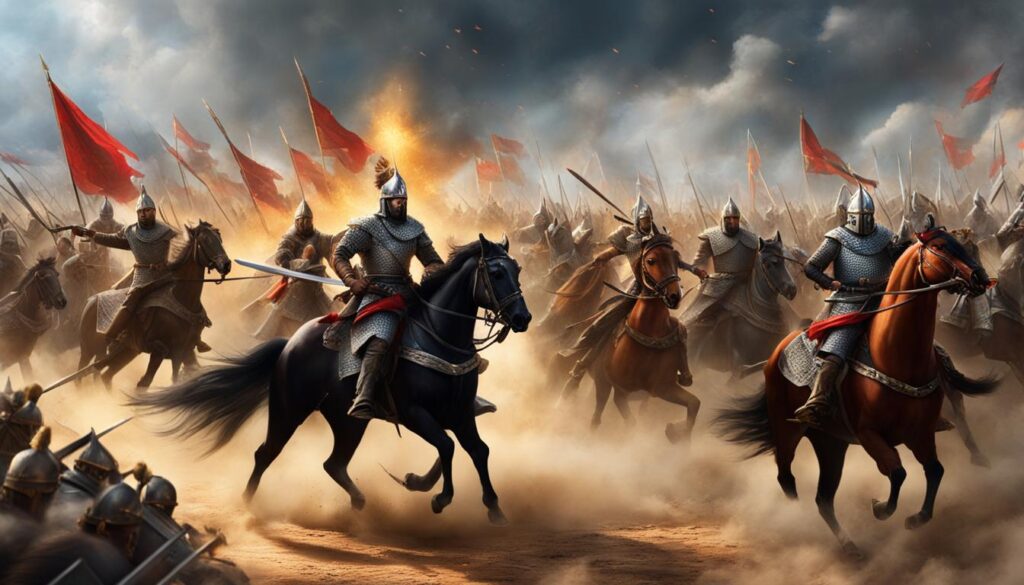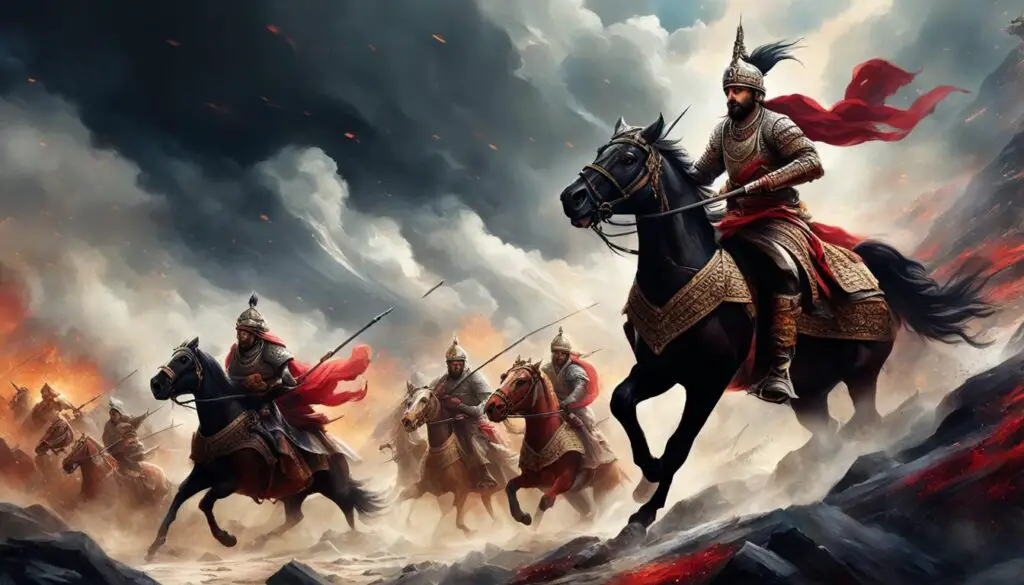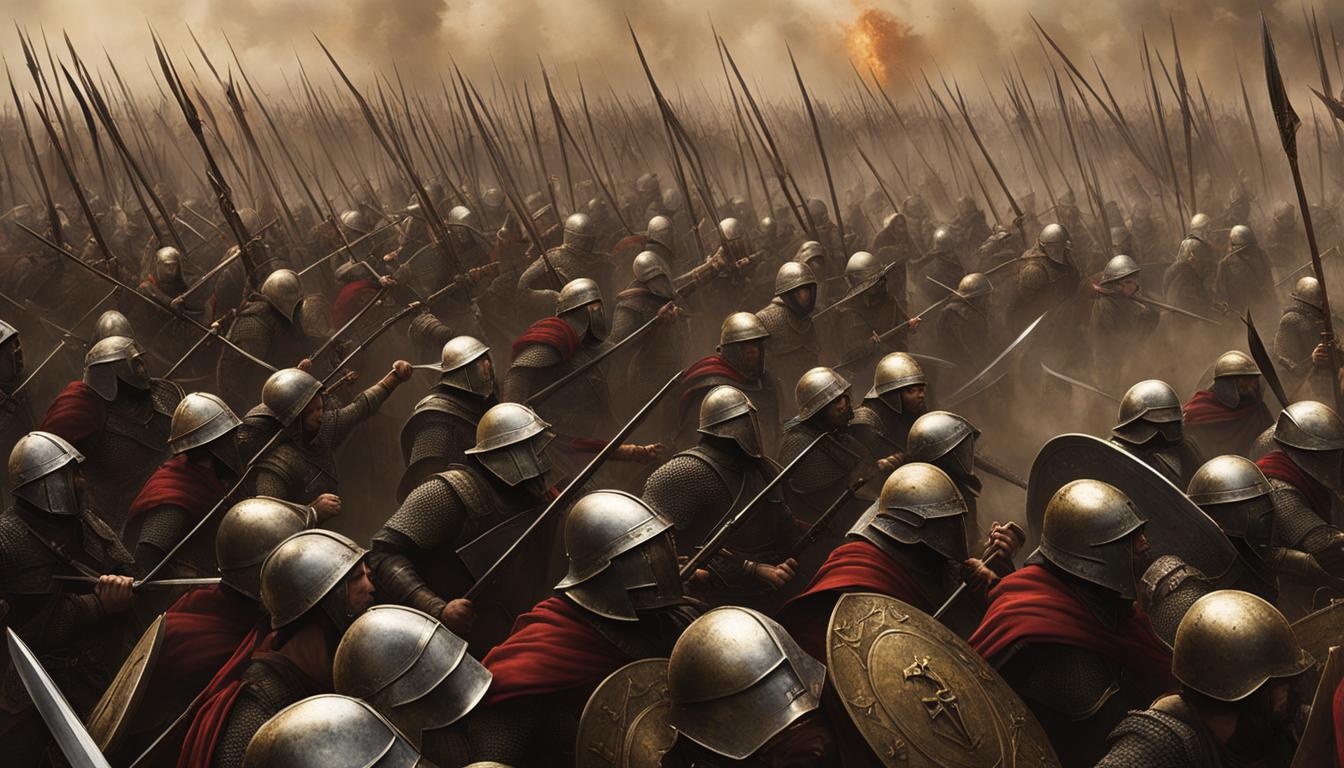Have you ever wondered about the ancient sagas that predate well-known epics like The Ramayana and The Mahabharata? Dive into the captivating world of Vedic history as we unravel the myths and truths behind the Battle of 10 Kings.
Step back in time and witness the legendary clash between King Sudas and a confederacy of powerful kings and chieftains. This riveting tale, known as the Dasharajnya, chronicles the epic struggle for survival and power in the region of Punjab.
Did Sudas, the descendant of Emperor Bharata, emerge victorious against incredible odds? Delve into the Rig Veda, the ancient text that holds the secrets to this extraordinary battle, and explore the interpretations that have fascinated historians for centuries.
Join us on this enthralling journey as we challenge common beliefs and shed light on the historical significance of the Battle of 10 Kings. Uncover the truth that lies behind the myths and discover how this ancient saga shaped Indian history.
Key Takeaways:
- Explore the Battle of 10 Kings, an ancient saga in Vedic history.
- Unravel the myths and truths surrounding this epic clash.
- Discover the historical significance of the battle and its impact on Indian history.
- Delve into the interpretations and debates surrounding the Dasharajnya War.
- Reflect on the complex nature of understanding ancient history and its implications.
King Sudas and the Confederacy
King Sudas, also known as Paijavana in the Rig Veda, was the 16th generation descendant of Emperor Bharata. He inherited the kingdom from his grandfather, King Divodas Atithigva, who had defeated the non-Aryan King Sambara in a long war.
Sudas greatly expanded his kingdom but alienated the neighboring kingdoms. This led to the formation of a confederacy of approximately ten kings and chieftains with the aim of defeating Sudas. The battle against this confederacy spanned many years and involved key battles.
Despite being vastly outnumbered, Sudas was able to defeat the entire confederacy and emerge as the victor. The details of the war can be found in the Rig Veda.
“Sudas, the son of Divodasa, performed the most glorious of deeds in war, he who, without assistance, was before all others.” – Rig Veda 7.33.6

Rig Veda and the Epic Battle
The Rig Veda, one of the oldest sacred texts of ancient India, provides detailed accounts of King Sudas’ heroic feats and his battle against the confederacy of kings. It highlights his strategic genius, valor, and divine assistance in overcoming the odds.
These hymns of praise in the Rig Veda celebrate the extraordinary achievement of Sudas, underscoring his triumph as a true leader and warrior. They solidify his place in history and elevate his status as a legendary figure.
The Legacy of King Sudas
King Sudas’ victory over the confederacy of kings not only secured his own kingdom but also established the supremacy of the Puru-Bharata Dynasty in the region. Sudas became an epitome of valor, leadership, and the embodiment of righteous rule.
The legacy of King Sudas and his triumph in the Dasharajnya War resonated throughout Indian history, highlighting the significance of unity, courage, and strategic acumen in the face of adversity. His story continues to inspire generations, exemplifying the resilience and power of the human spirit.
| Key Takeaways |
|---|
| King Sudas, the 16th generation descendant of Emperor Bharata, inherited the kingdom from his grandfather and faced the challenge of a confederacy of kings. |
| Despite being outnumbered, Sudas emerged victorious in the battle, as described in the Rig Veda. |
| The Rig Veda celebrates Sudas’ heroic achievements and emphasizes his strategic genius and valor. |
| King Sudas’ victory ensured the supremacy of the Puru-Bharata Dynasty and left a lasting legacy in Indian history. |
Debates and Interpretations
There are debates and interpretations surrounding the Dasharajnya War, shedding light on the complex nature of understanding ancient history and its implications. Some historians, influenced by theories such as the Aryan Invasion Theory (AIT), have taken a negationist stance on the historical basis of the war.
Attributing ancient Indian history through the lens of a supposed invasion by Aryans around 1500 BCE, these historians interpret the Vedic texts, including the Rig Veda, as purely mythological and fictional. They deny the existence of the ancient kings mentioned and dismiss the war as a mere product of mythology.
“The Aryan Invasion Theory challenges the historical basis of the Dasharajnya War and relegates it to the realm of mythology, questioning the authenticity of the ancient kings and the events described in the Rig Veda.” – Dr. Anushka Sharma, Historian
On the other hand, alternative views challenge the negationist stance and consider these ancient kings to be real historical figures. These historians interpret the war as a significant event in Indian history, showcasing the prowess and strategic brilliance of King Sudas and his victory against the confederacy of kings.
Contrary to the negationists’ claims, these alternative interpretations highlight the historical basis of the Dasharajnya War, emphasizing its importance in shaping the political landscape of ancient India. Through these differing perspectives, the debates surrounding the war continue to spark intellectual discourse and evolve our understanding of the past.
Unraveling Mythology and History
One of the main points of contention in the debates surrounding the Dasharajnya War is differentiating between mythology and history. While the negationist stance dismisses the war as pure mythology, proponents of the historical basis argue that mythology can often contain elements of historical truth.
“Mythology can provide glimpses into historical events, customs, and traditions that may have been passed down through generations, deeply embedded within the cultural fabric of a society.” – Prof. Arjun Kapoor, Mythologist
As such, delving into the Dasharajnya War with an open mind can lead to a nuanced understanding of ancient Indian history, recognizing that mythology and history are intertwined.

Conclusion
The Battle of 10 Kings, also known as the Dasharajnya War, holds immense significance in the annals of Indian history. It represents a historical milestone that marked a pivotal moment in the dominance of the Puru-Bharata Dynasty, which can trace its lineage back to the illustrious Emperor Bharata. The Puru-Bharata Dynasty’s continuity of leadership spanned thousands of years, shaping the destiny of the Indian subcontinent.
Through this grand war, the Puru-Bharata Dynasty solidified its dominance over smaller royal dynasties and tribal chieftains in the region, spanning from present-day Afghanistan/Persia to Uttar Pradesh. This epic clash of kings and chieftains reshaped the political landscape, establishing the Puru-Bharata Dynasty as the ruling force in the vast territory. The war cemented their authority and paved the way for the dynasty’s continued leadership for generations to come.
While the historical accuracy of the Dasharajnya War has been a subject of debate among scholars, its significance as a historical milestone cannot be overlooked. This glorious battle, deserving recognition on par with the renowned epics of The Ramayana and The Mahabharata, served as a testament to the enduring legacy of the Puru-Bharata Dynasty and its profound impact on India’s ancient history.
FAQ
What is the Battle of 10 Kings?
The Battle of 10 Kings, also known as the Dasharajnya, is an ancient story that predates even the well-known epics of The Ramayana and The Mahabharata. It revolves around King Sudas, a descendant of Emperor Bharata, who ruled the region of Punjab.
Who was King Sudas?
King Sudas, also known as Paijavana in the Rig Veda, was the 16th generation descendant of Emperor Bharata. He inherited the kingdom from his grandfather, King Divodas Atithigva, who had defeated the non-Aryan King Sambara in a long war.
What happened in the Battle of 10 Kings?
In response to Sudas’ actions, a confederacy of approximately ten kings and chieftains formed with the aim of defeating Sudas. The battle against this confederacy spanned many years and involved key battles. Despite being vastly outnumbered, Sudas was able to defeat the entire confederacy and emerge as the victor.
Are there debates surrounding the Dasharajnya War?
Yes, there are debates and interpretations surrounding the Dasharajnya War. Some historians interpret the Vedic texts, including the Rig Veda, as mythological and fictional, denying the historical basis of the ancient kings mentioned. However, alternative views consider these ancient kings to be real and interpret the war as a significant event in Indian history.
What is the historical significance of the Battle of 10 Kings?
The Battle of 10 Kings holds great significance in Indian history as it marked a turning point in the dominance of the Puru-Bharata Dynasty. This dynasty, with its lineage traced back to Emperor Bharata, provided the continuity of leadership for thousands of years. The war solidified the Puru-Bharata Dynasty’s dominance over smaller royal dynasties and tribal chieftains in the region.
Source Links
- https://www.sanskritimagazine.com/dasarajna-battle-ten-kings-rig-veda/
- https://www.themysteriousindia.net/battle-ten-kings/
- https://www.goodreads.com/book/show/14832272-ten-kings
